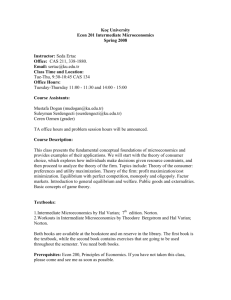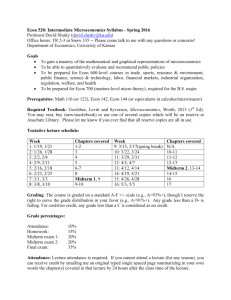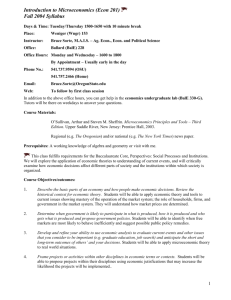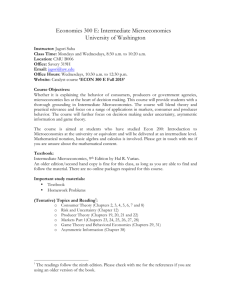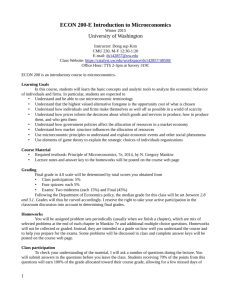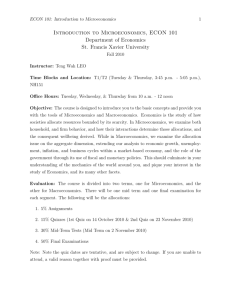ECON 50 – ECONOMIC ANALYSIS I Summer 2015 Simon W
advertisement
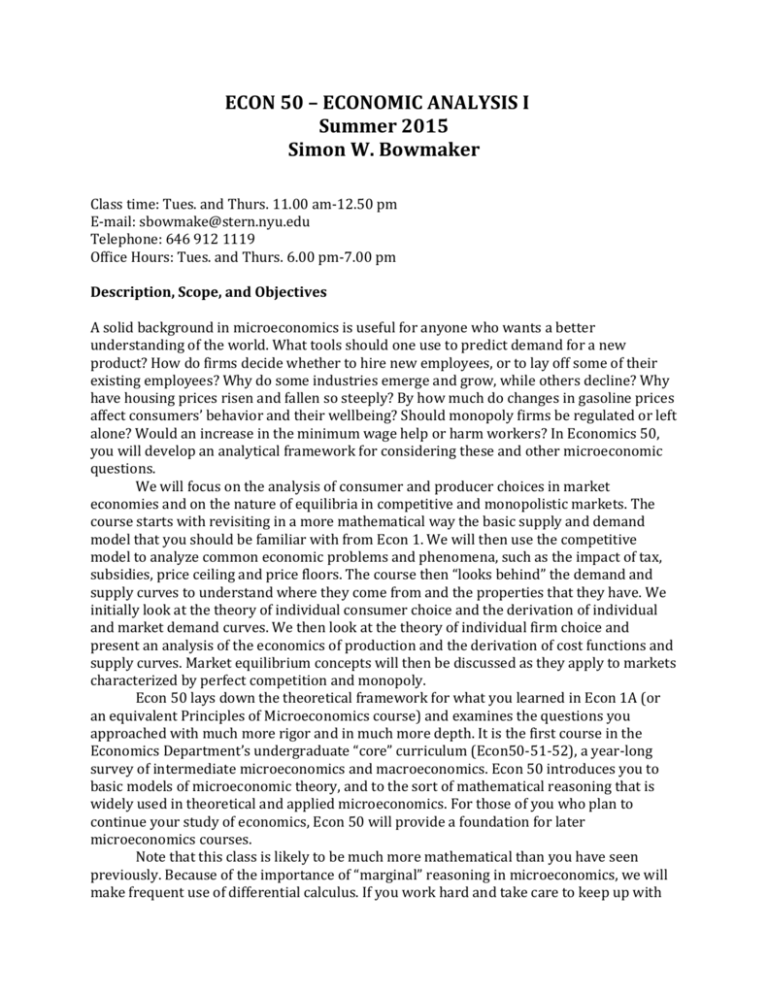
ECON 50 – ECONOMIC ANALYSIS I Summer 2015 Simon W. Bowmaker Class time: Tues. and Thurs. 11.00 am-12.50 pm E-mail: sbowmake@stern.nyu.edu Telephone: 646 912 1119 Office Hours: Tues. and Thurs. 6.00 pm-7.00 pm Description, Scope, and Objectives A solid background in microeconomics is useful for anyone who wants a better understanding of the world. What tools should one use to predict demand for a new product? How do firms decide whether to hire new employees, or to lay off some of their existing employees? Why do some industries emerge and grow, while others decline? Why have housing prices risen and fallen so steeply? By how much do changes in gasoline prices affect consumers’ behavior and their wellbeing? Should monopoly firms be regulated or left alone? Would an increase in the minimum wage help or harm workers? In Economics 50, you will develop an analytical framework for considering these and other microeconomic questions. We will focus on the analysis of consumer and producer choices in market economies and on the nature of equilibria in competitive and monopolistic markets. The course starts with revisiting in a more mathematical way the basic supply and demand model that you should be familiar with from Econ 1. We will then use the competitive model to analyze common economic problems and phenomena, such as the impact of tax, subsidies, price ceiling and price floors. The course then “looks behind” the demand and supply curves to understand where they come from and the properties that they have. We initially look at the theory of individual consumer choice and the derivation of individual and market demand curves. We then look at the theory of individual firm choice and present an analysis of the economics of production and the derivation of cost functions and supply curves. Market equilibrium concepts will then be discussed as they apply to markets characterized by perfect competition and monopoly. Econ 50 lays down the theoretical framework for what you learned in Econ 1A (or an equivalent Principles of Microeconomics course) and examines the questions you approached with much more rigor and in much more depth. It is the first course in the Economics Department’s undergraduate “core” curriculum (Econ50-51-52), a year-long survey of intermediate microeconomics and macroeconomics. Econ 50 introduces you to basic models of microeconomic theory, and to the sort of mathematical reasoning that is widely used in theoretical and applied microeconomics. For those of you who plan to continue your study of economics, Econ 50 will provide a foundation for later microeconomics courses. Note that this class is likely to be much more mathematical than you have seen previously. Because of the importance of “marginal” reasoning in microeconomics, we will make frequent use of differential calculus. If you work hard and take care to keep up with the material, you will do much better in this class, and more importantly, in all subsequent economics courses you take. Pre-requisites Econ 1A or its equivalent, Math 51 or its equivalent, facility with differential calculus. If you have satisfied these requirements via transfer credit, please contact Mrs. Joanne DeMarchena (jdemar@stanford.edu) who will be able to provide you with an Axess registration code to register. Note that you cannot take any of the prerequisites concurrently with Econ 50. Textbook Besanko, David and Braeutigam, Ronald R. Microeconomics, fifth edition, Wiley 2013 (note: previous editions are fine). Grading Problem Sets 20% Midterm 35% Final Exam 45% Problem Sets Problem sets constitute a major part of the course grade (20%), and an even larger part of your learning. Please take the problem sets seriously: Econ 50 is a learning-by-doing course and solving problem sets will be a good preparation for the exams. I encourage you to work in groups on these problem sets, but the final submission should be your own work. Problem sets will be submitted in section. No late problem sets will be accepted. I will drop your lowest problem set score. Midterm and Final Exams There will be one midterm exam during class on Tuesday, October 29 from 1:15pm3:05pm (in class); the final exam will be on Thursday, December 12, from 7:00pm to 10:00pm. There will be no make-up exams, and no early or late sittings for exams. Course website I will be using the CourseWork portal (https://coursework.stanford.edu/portal/), where you will find announcements, sample exams, and lecture slides. Classroom norms Laptops, cell phones, and other electronic devices are a disturbance to both students and professors. All electronic devices must be turned off prior to the start of each class meeting. Responsibilities We are all adults. As the teacher, I have the responsibility to organize and present the material and to facilitate your learning. As a student, you have responsibility for your own learning. All students enrolled in this class, regardless of whether or not they are matriculated students, are expected to abide by the Stanford Honor Code. If you are not familiar with the honor code, you should read over the guidelines listed at the following link: http://www.stanford.edu/dept/vpsa/judicialaffairs/guiding/honorcode.htm. Students with documented disabilities Students who have a physical or mental impairment that may necessitate an academic accommodation or the use of auxiliary aids and services in a class must initiate a request with the Student Disability Resource Center (DRC). The DRC will evaluate the request along with the required documentation, recommend appropriate accommodations, and prepare a verification letter dated in the current academic term in which the request is being made. Please contact the DRC as soon as possible; timely notice is needed to arrange for appropriate accommodations. The DRC is located at 563 Salvatierra Walk (phone 723-1066 Voice; 725-1067 TTY). Course schedule Date Topic Reading Tuesday, June 23 Introduction to microeconomics; course overview Supply and demand analysis; elasticities Interventions in competitive market outcomes Preferences, indifference curves, and utility functions, I Preferences, indifference curves, and utility functions, II Budget constraints; optimal consumer choice Optimal choice applications; revealed preference Optimal choice, demand, and demand curves Midterm Introduction to producer theory Cost and cost minimization Cost and cost minimization, further applications, I Cost and cost minimization, further applications, II Profit maximization Market supply B&B, Chapter 1 Thursday, June 25 Tuesday, June 30 Thursday, July 2 Tuesday, July 7 Thursday, July 9 Tuesday, July 14 Thursday, July 16 Tuesday, July 21 Thursday, July 23 Tuesday, July 28 Thursday, July 30 Tuesday, August 4 Thursday, August 6 Tuesday, August 11 Thursday, August 13 Saturday, August 15 (8.30 am – 11.30 am) Welfare analysis; monopoly and monopsony Final Exam B&B, Chapters 1 and 2 B&B, Chapter 10 B&B, Chapter 3 B&B, Chapter 3 B&B, Chapter 4 B&B, Chapter 4 B&B, Chapter 5 B&B, Chapter 6 B&B, Chapter 7 B&B, Chapter 7 B&B, Chapter 8 B&B, Chapter 9 B&B, Chapter 9 B&B, Chapters 10 and 11

